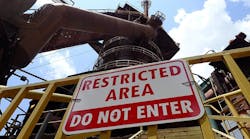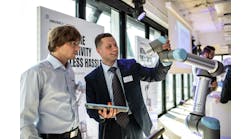What level of safety protection is needed for the production floor?
A Control Design reader writes: What role does presence sensing play in test cells and work cells? What is the approved procedure to sense and lock cell doors and still meet fire code exit requirements?
Minimum safe distance
Safety presence-sensing devices, such as safety scanners, safety mats or safety light curtains, can be a simple and efficient solution to keep your employees safe while allowing easy access to work or test cells. In comparison to an interlocked movable guard, such as a door or gate, a safety presence device offers operators the convenience of safely being able to reach or walk into a hazard area as is necessary. It’s also much easier to install for machine builders. To ensure those devices are effective and compliant, however, you need to consider three important factors.
First, you can only use safety presence-sensing devices as the primary means of protecting an employee from a hazard when the machine can be stopped at any point in its operational cycle. As the name implies, safety presence devices rely on detecting the presence of a person and sending a stop signal to the control system of the machine to halt the hazardous motion before the machine and the person can interact.
Critical for the effectiveness of the safety solution is to be able to predict how long it will take all hazardous motion to stop if the safety device is triggered. If there is no way for the control system to stop the machine once the cycle is started, such as with a full-revolution press, then there is no way to predict how long the hazardous motion will continue. Instead, when faced with machines that have uncontrolled stops, you will need to rely on some form of interlocked hard guarding at the point of operation to protect the employees.
Second, you need to mount the safety device at the minimum safe distance to ensure that it will adequately protect your employees. The minimum safe distance is how far away from a hazard a safety device should be installed to make certain that it would protect the employee. While there are some variations, the basic concept of the minimum safe distance (Ds) can be expressed by the equation:
Ds = (KT) + C
K = approach speed constant (63 inch/s)
T = total stopping time of the machine. This time includes safety device response time, response of the control system and the actual time it takes for the hazardous motion to stop. While this value can be calculated, best practice calls to actually measure it using a stop time device.
C = depth of penetration for the safety device. This is a value provided by the manufacturer of the safety device and represents the maximum distance that a given sized object can travel into the range of the safety device before it will trigger the device.
For example, if you have a machine that has a total stopping time of 0.25 seconds and a safety device that has a depth of penetration value of 1 inch, then the safe mounting distance is 16.75 inches. The goal to set the minimum safe distance is to ensure that, once someone triggers the safety device, it will allow sufficient time for the machine to stop before the person would reach the hazard.
Finally, engineers commonly use safety scanners and safety mats in fenced robotic or other heavy equipment work cells that are only accessible by a gate with safety guard locking devices. In these applications, the fenced perimeter with the interlock gate is protecting access to the hazard. The safety presence device is there to ensure that no one is trapped in the hazard zone prior to a machine restart. There are two important considerations in this type of application.
One, the safety device needs to be able to cover the entire area enclosed by the fence, without any shadows or dead zones in its sensing field. You need to avoid having gaps big enough for a person to be in, such as behind a large pole. If there is a dead zone or if the sensing distance is not long enough to cover the entire cell, then it’s necessary to use multiple devices to cover the cell.
Second, with any fenced work cell where access is controlled by a guard locking gate, best practice is to have some type of a manual release on the inside of the door. Since many guard locking solutions rely on “power to open,” having a manual release on the inside ensures that, if people are in the cell and need to exit in an emergency, such as for a fire, they will have a quick and easy way to leave the area.
TODD MASON-DARNELL / marketing manager, safety & service / Omron Automation Americas
ALSO READ: How to make the right safety and sensing decisions
[sidebar id=1]





